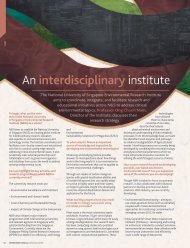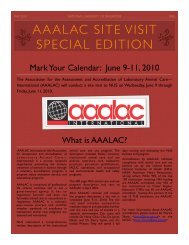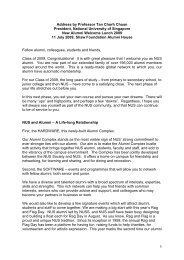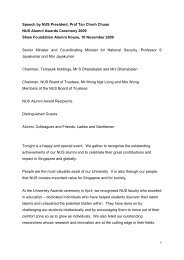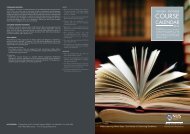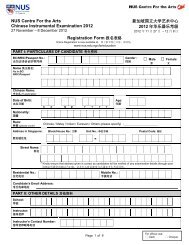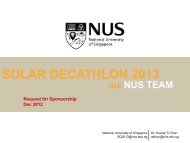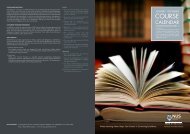Transforming C60 molecules into Graphene Quantum Dots
Transforming C60 molecules into Graphene Quantum Dots
Transforming C60 molecules into Graphene Quantum Dots
You also want an ePaper? Increase the reach of your titles
YUMPU automatically turns print PDFs into web optimized ePapers that Google loves.
<strong>Transforming</strong> <strong>C60</strong> <strong>molecules</strong> <strong>into</strong> <strong>Graphene</strong> <strong>Quantum</strong> <strong>Dots</strong><br />
Kian Ping Loh and Jiong Lu<br />
Department of Chemistry, National University of Singapore<br />
<strong>Graphene</strong> is a one-layer thick sheet of carbon atoms arranged in a honeycomb structure.<br />
Unlike the stacked carbon sheets in graphite, the isolated sheet is decoupled from other<br />
carbon sheets. This stand-alone nature of graphene coupled with the special symmetry of<br />
its honeycomb structure creates very fascinating and unique electronic properties in this<br />
material. Due to the fact that graphene is a single atomic sheet with no bulk, when it is<br />
used as active material in devices, it represents the ultimate limit in terms of the vertical<br />
downsizing.<br />
A major hindrance for graphene to be fully utilized for next-generation nanoelectronics is its<br />
lack of an energy gap. The presence of an energy gap is essential for a transistor to<br />
achieve a good on-off ratio in switching. One way to engineer a band gap in graphene is to<br />
geometrically confine the size of graphene. For example, using lithographical techniques,<br />
graphene can be patterned <strong>into</strong> very narrow ribbons or very small dots. In these cases,<br />
owing to quantum confinement and edge effects, a band gap can be opened up in the<br />
material. However, structures with lateral dimension smaller than 10 nm are usually needed<br />
to achieve quantum confinement, and to fabricate such small structures is highly<br />
challenging using conventional top-down lithographical approaches.<br />
The team of KP LOH and Jiong Lu [1] considered a bottom-up assembly approach using<br />
C 60 <strong>molecules</strong> as the precursor for the generation of graphene. The idea is simple: every<br />
fullerene molecule has the same size and shape, so the fragmentation of fullerene, if<br />
carried out under well-controlled conditions, should produce uniformly-sized graphene<br />
quantum dots. They show that when C 60 <strong>molecules</strong> are adsorbed on Ruthenium (Ru) crystal
at low coverage, the Ru-catalyzed cage-opening of fullerene provides a controllable route to<br />
the templated synthesis of graphene quantum dots. Using Scanning Tunneling Microscopy,<br />
the team found that the fragmentation of the C 60 <strong>molecules</strong> at elevated temperatures<br />
produces highly symmetrical carbon cluster that undergo diffusion and aggregation to form<br />
geometrically well defined quantum dots. These results provide valuable insights <strong>into</strong> the<br />
diffusion and thermal dynamics of carbon clusters on metal surfaces.<br />
Reference<br />
[1] <strong>Transforming</strong> C-60 <strong>molecules</strong> <strong>into</strong> graphene quantum dots<br />
Lu J (Lu, Jiong) 1 , Yeo PSE (Yeo, Pei Shan Emmeline) 1,2 , Gan CK (Gan, Chee Kwan) 2 , Wu P<br />
(Wu, Ping) 2 , Loh KP *(Loh, Kian Ping) 1<br />
Source: Nature Nanotechnology, 6, 247–252, (2011), doi:10.1038/nnano.2011.30<br />
The work has been highlighted in http://nanotechweb.org/cws/article/tech/45526.<br />
[2] <strong>Graphene</strong> oxide as a chemically tunable platform for optical applications<br />
Loh KP*, Bao QL, Eda G, et al.<br />
NATURE CHEMISTRY Volume: 2 Issue: 12 Pages: 1015-1024 Published: DEC 2010<br />
-------------------------------------------------------------------------------------------------------------------------<br />
The full paper can be accessed via<br />
http://www.nature.com/nnano/journal/v6/n4/full/nnano.2011.30.html<br />
For NUS staffs and students, you can access to the full paper via<br />
http://www.nature.com.libproxy1.nus.edu.sg/nnano/journal/v6/n4/full/nnano.2011.30.html




